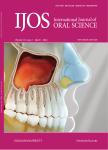Tooth number abnormality:from bench to bedside
作者机构:Department of ImplantologyStomatological Hospital and Dental School of Tongji UniversityShanghai Engineering Research Center of Tooth Restoration and RegenerationShanghaiChina Key Laboratory of Big Data-Based Precision MedicineSchool of Engineering MedicineBeihang UniversityBeijingChina
出 版 物:《International Journal of Oral Science》 (国际口腔科学杂志(英文版))
年 卷 期:2023年第15卷第1期
页 面:1-15页
核心收录:
学科分类:1003[医学-口腔医学] 100302[医学-口腔临床医学] 10[医学]
基 金:supported by grants from the National Key R&D Program of China(2022YFA1103201) Shanghai Academic Leader of Science and Technology Innovation Action Plan(20XD1424000) Shanghai Experimental Animal Research Project of Science and Technology Innovation Action Plan(201409006400) National Natural Science Foundation of China(82270963,82061130222)awarded to Y.S. National Natural Science Foundation Projects of China(92049201)awarded to X.W.
主 题:abnormality diagnosis epithelium
摘 要:Tooth number abnormality is one of the most common dental developmental diseases,which includes both tooth agenesis and supernumerary teeth.Tooth development is regulated by numerous developmental signals,such as the well-known Wnt,BMP,FGF,Shh and Eda pathways,which mediate the ongoing complex interactions between epithelium and mesenchyme.Abnormal expression of these crutial signalling during this process may eventually lead to the development of anomalies in tooth number;however,the underlying mechanisms remain elusive.In this review,we summarized the major process of tooth development,the latest progress of mechanism studies and newly reported clinical investigations of tooth number abnormality.In addition,potential treatment approaches for tooth number abnormality based on developmental biology are also discussed.This review not only provides a reference for the diagnosis and treatment of tooth number abnormality in clinical practice but also facilitates the translation of basic research to the clinical application.



